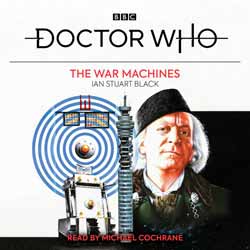|
Click here to return to the main site. Audio Book Review
The TARDIS materialises outside the Post Office Tower in London, 1966. The Doctor senses a powerful and evil force, which he and the ever-curious Dodo track down to scientist Professor Brett and WOTAN, his revolutionary new computer. Designed as a universal problem solver, WOTAN has suddenly begun to think for itself and has formulated a deadly plan. Using its phenomenal power it will program humans to build mobile fighting computers, and with these indestructible war machines WOTAN will take over the world. With the help of Dodo, Sir Charles Summer, and new friends Ben and Polly, the Doctor must find a way to prevent a global catastrophe… Let’s get one thing out of the way first. Michael Cochrane is a rather random choice of reader for this unabridged First Doctor novelisation. The back cover informs us that he “has played several roles in the BBC TV series,” which rather overlooks the fact that he has no connection to the 1966 serial on which this audio book is based. Cochrane appeared in a couple of Doctor Who adventures in the 1980s, which is a different era entirely from the story’s original transmission… though not a million miles away from the date of the book’s publication in 1989. The reader may be ahead of his time, but so are several other aspects of the tale… The War Machines set the style for adventures that would become commonplace for subsequent incarnations of the Time Lord. The television serial is one of only two featuring William Hartnell that takes place entirely on present-day Earth (the other being Planet of Giants). The involvement of the army paved the way for UNIT, the paramilitary organisation that became a mainstay of the show from the late 1960s to the mid-1970s. In the book, the Doctor thinks it’s “Wonderful” to be back in contemporary London. “He had always enjoyed England,” the narrative informs us during the opening chapter. “What a pleasure to find ourselves here,” he subsequently remarks to his companion Dodo. He’s changed his tune since An Unearthly Child, in which he told Ian and Barbara that, “I tolerate this century, but I don’t enjoy it.” Talking of Ian, the novelisation also looks beyond its mid-1960s origins, being as much a product of the 1980s. Rectifying a shortcoming of his original scripts, in which the Doctor is admitted into Professor Brett’s laboratory with barely any ado, author Ian Stuart Black has the Time Lord gaining access with the aid of forged credentials (a very Seventh Doctor tactic) and the fact that he and Brett have a mutual acquaintance in Ian Chesterton (a very 1980s kind of continuity reference). The benefit of hindsight influences the text. In an additional TARDIS scene at the beginning of the book, the Doctor ponders that the Post Office Tower will have different names in later decades. He and Dodo also realise, with some sadness, that their return to London will probably result in a parting of the ways. This helps to compensate for Dodo’s undignified departure halfway through the television serial (because the actress’s contract had run out). The term “TARDIS crew” is often bandied around in writings about Doctor Who, but in this chapter Black makes a point of having Dodo act as a proper crewmember, operating the TARDIS computer as the ship comes in to land. In terms of computing, the concept of WOTAN was also ahead of its time. The idea (which came from the show’s science consultant Kit Pedler) of a worldwide network of computers obviously predicts the Internet. The notion of a governing artificial intelligence that decides the world would be better off without human beings, and so devises an army of killing machines to wipe us out, is like a lower-tech version of Skynet from the Terminator movies. WOTAN and its war machines were let down on screen by their clunky design, but they become a more potent menace in print and on audio. The novelist describes them as having a square head atop a human-like body. He also reinstates an idea that didn’t make it into the televised version, whereby the hands of those under WOTAN’s control take on a skeletal appearance. Key lines of dialogue are also reworked so that WOTAN and Professor Brett refer to the main character as “the Doctor” rather than “Doctor Who” – the first episode famously ended with the controversial line, “Doc… tor… Who… is… re… quired.” Appropriately enough, this tale of man versus heartless machine is given a compassionate reading by Cochrane. Witness the poignancy of the Doctor facing the fact that he may soon be travelling alone, or the desperation of the tramp who has an ill-fated encounter with a group of WOTAN’s slaves. Despite his age (he’s in his early seventies), the reader’s First Doctor voice doesn’t sound much like Hartnell, because Cochrane’s vocal qualities are deeper and throatier. I suspect that he would be good at rendering the Second or Third Doctor, though (BBC Audio, please take note), and he is well suited to voicing the aged scientist Sir Charles Summer. One thing that is definitely in keeping with the Swinging Sixties setting is the groovy music heard playing at the Inferno nightclub, which comes courtesy of sound designer Simon Power. All in all, this upgraded version of Doctor Who: The War Machines is re… quired listening. 8 Richard McGinlay Buy this item online
|
|---|

